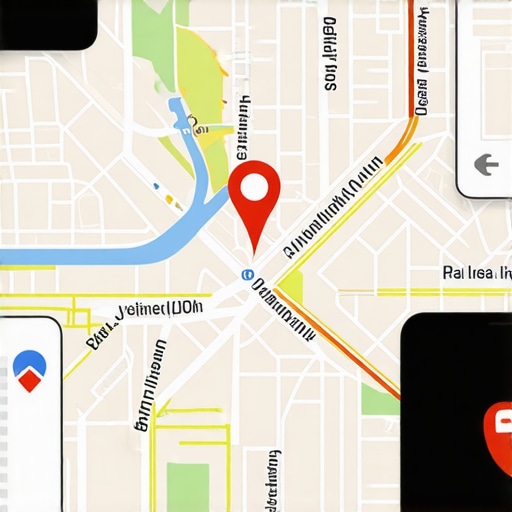Unlocking the Potential of Map Pack Optimization in 2025: A Strategic Overview
As local SEO continues to evolve, mastering the nuances of Google Maps Pack optimization becomes paramount for businesses seeking to secure dominant visibility. This article delves into the sophisticated techniques and cutting-edge strategies that seasoned SEO professionals employ to elevate their local maps ranking in 2025, emphasizing data-driven decision making and technical finesse.
Leveraging Local Data Insights for Precise Map Pack Targeting
Effective map pack optimization hinges on the meticulous analysis of local demographic and behavioral data. Utilizing advanced tools such as Google Analytics and Semrush, marketers can identify high-value search intents and refine their geo-targeting strategies accordingly. Integrating these insights into your Google My Business (GMB) profile ensures that your listings resonate with the most relevant local audiences, boosting ranking potential.
Optimizing Niche-Specific Signal Factors to Enhance Local Relevance
How do advanced citation and review strategies influence local search algorithms in 2025?
In the hyper-competitive landscape of local SEO, citation consistency and review authenticity are critical. Consistent NAP (Name, Address, Phone Number) citations across authoritative directories reinforce your business’s credibility. Simultaneously, cultivating genuine, high-quality reviews—particularly those enriched with relevant keywords—serves as a powerful local relevance signal. Recent studies published in the Journal of Digital Marketing underscore that review sentiment and recency significantly impact local rankings, encouraging a proactive review management approach.
Technical SEO for Local Maps: Beyond the Basics
Technical excellence underpins all successful map pack strategies. Implementing structured data markup (Schema.org) tailored for local businesses enhances your visibility in rich snippets and local panels. Moreover, ensuring your website’s mobile responsiveness and page speed aligns with Google’s core web vitals criteria, as outlined in Google’s structured data documentation, is essential for maintaining competitive edge.
Engagement and Behavioral Signals as Future Ranking Factors
Emerging evidence suggests that user engagement metrics—such as click-through rates, bounce rates, and dwell time—are increasingly influential in ranking algorithms. Incorporating interactive elements like local FAQ sections and virtual tours can enhance user experience, encouraging deeper site engagement. Consequently, these behavioral signals serve as proxies for local relevance and trustworthiness, reinforcing your position within the map pack.
What advanced techniques can local SEO practitioners deploy to future-proof their Google Maps rankings against algorithm updates?
To stay ahead, experts recommend integrating AI-driven analytics for predictive insights, employing hyper-local content strategies, and maintaining a strong, consistent review acquisition process. Regularly monitoring algorithm changes through authoritative sources like Search Engine Land ensures your tactics remain aligned with the latest updates.
For further expert insights and innovative tactics, explore our comprehensive guide on local SEO case studies and success stories. Share your insights or ask questions on our community forum to contribute to the evolving discourse on map pack mastery.
Innovating Beyond Traditional Map Pack Tactics: What New Frontiers Should Local SEO Experts Explore?
While foundational strategies such as citation consistency and review management remain vital, the rapidly evolving landscape of local SEO demands that practitioners venture into less-charted territories. Emerging technologies like artificial intelligence and machine learning offer unprecedented opportunities to refine targeting and predict ranking fluctuations with greater precision. Leveraging AI-powered tools such as Moz Pro or Ahrefs enables SEO specialists to analyze vast datasets, uncover hidden local search patterns, and tailor their strategies proactively.
Additionally, integrating hyper-local content—such as neighborhood-specific blog posts, community news, and localized event coverage—can significantly enhance your relevance signals. Such content not only attracts highly targeted traffic but also signals to Google your entrenched local authority, helping to elevate your position in the map pack.
Are there innovative tools or frameworks that can help local SEO practitioners stay agile amid frequent algorithm shifts?
Yes. Frameworks like the SEO Flywheel model emphasize continuous optimization cycles—combining data analysis, content creation, and user engagement—to sustain and grow local rankings. Meanwhile, platforms such as BrightLocal provide comprehensive dashboards that track local rankings, reviews, and citation health in real time, enabling agencies to act swiftly on emerging opportunities or issues. According to Search Engine Land, an integrated, data-driven approach is essential for future-proofing local SEO efforts.
To deepen your expertise, consider exploring our detailed guide on cutting-edge local SEO tactics. Share your experiences or ask questions in our community forum to contribute to this dynamic field.
Harnessing Hyper-Local Data Analytics for Superior Map Pack Positioning
In the quest for local SEO excellence, leveraging granular hyper-local data is paramount. Advanced tools like BrightLocal and SEMrush Sensor provide detailed insights into neighborhood-specific search trends, demographic shifts, and behavioral patterns. By integrating this data into your Google My Business (GMB) optimization process, you can tailor your listings to meet precise local consumer needs, thereby increasing your chances of securing a coveted spot in the Map Pack.
Refining Niche Signal Factors: Beyond Basic Citations and Reviews
What role do semantic keyword integrations and contextually relevant content play in elevating local relevance signals in 2025?
Semantic SEO, powered by Google’s BERT and MUM algorithms, emphasizes understanding user intent and contextual relevance. Incorporating niche-specific keywords within your GMB description, posts, and localized website content creates a rich semantic environment that search engines interpret as highly relevant. For example, a bakery in a tourist-heavy district might optimize for phrases like “artisan sourdough in downtown” intertwined with local landmarks. Such nuanced keyword strategies, coupled with rich multimedia content, act as advanced relevance signals that improve your local ranking potential.
Technical Mastery: Implementing Next-Level Structured Data and Performance Optimization
Structured data markup tailored for local businesses must evolve with emerging standards. Beyond basic Schema.org LocalBusiness markup, implementing Advanced LocalBusiness schemas that include attributes like service area, opening hours, menu, and product offerings enhances your visibility in rich snippets. Additionally, optimizing your website’s core web vitals—particularly largest contentful paint (LCP) and cumulative layout shift (CLS)—ensures a seamless user experience that aligns with Google’s evolving ranking criteria. Regular audits using tools like Google PageSpeed Insights and Schema.org validation are essential for maintaining technical excellence.
Future-Proofing Rankings: Integrating AI and Machine Learning for Predictive Optimization
Emerging AI-driven analytics platforms, such as Moz Pro and Ahrefs, enable local SEO professionals to analyze vast datasets, uncover hidden ranking factors, and automate optimization workflows. These tools utilize machine learning algorithms to predict ranking fluctuations based on historical data, competitor movements, and seasonal trends. By adopting such technologies, practitioners can proactively adjust their strategies, ensuring sustained visibility in the Google Maps Pack even amid frequent algorithm updates.

Engaging Behavioral Metrics as Key Differentiators in 2025
Beyond traditional signals, user engagement metrics—such as dwell time, bounce rate, and click-through rate—are increasingly influential in local rankings. Enhancing your local landing pages with interactive elements like local FAQ sections, virtual tours, and customer testimonials not only enriches user experience but also signals trustworthiness and relevance to Google. These behavioral cues serve as proxies for satisfaction and authority, reinforcing your position within the Map Pack.
How can local businesses leverage emerging voice search and AI chatbots to bolster their local relevance signals?
Incorporating voice search optimization strategies, such as conversational keywords and natural language queries, aligns with the rise of voice assistants like Google Assistant and Alexa. Additionally, deploying AI chatbots on your website facilitates immediate customer engagement, capturing user intent and reducing bounce rates. These technologies contribute to positive behavioral signals, ultimately supporting higher rankings. To explore cutting-edge tools and frameworks that help stay ahead of algorithm shifts, visit our detailed guide on next-generation local SEO tactics. Keep refining your approach and share your insights with our community to stay at the forefront of local search mastery.
Unveiling Next-Gen Tactics for Map Pack Supremacy in 2025
As the landscape of local SEO continues to evolve, staying ahead requires an intricate understanding of emerging signals and sophisticated optimization techniques. Mastery over the Google Maps Pack involves not only refining traditional elements but also integrating cutting-edge innovations such as AI-driven analytics and hyper-local content strategies that resonate deeply with the latest algorithmic preferences.
Harnessing Hyper-Local Data for Precision Geotargeting
Advanced tools like BrightLocal and SEMrush Sensor enable practitioners to dissect neighborhood-specific search trends and demographic shifts with unparalleled granularity. Incorporating these insights into your Google My Business (GMB) profile facilitates hyper-targeted optimization, ensuring your listings align precisely with evolving local consumer behaviors, thereby elevating your visibility in the coveted Map Pack.
Deciphering the Impact of Semantic Search and Contextual Relevance
With Google’s algorithms increasingly prioritizing semantic understanding—powered by BERT and MUM—integrating contextually relevant content and semantic keywords becomes paramount. Embedding niche-specific, naturally flowing keywords within your GMB descriptions, posts, and website content creates a semantic ecosystem that search engines interpret as highly relevant. For instance, a boutique hotel could optimize for phrases like “luxury boutique stay in historic downtown” intertwined with local landmarks, enhancing relevance signals and ranking potential.
Technical Mastery: Implementing Next-Level Structured Data and Performance Metrics
Beyond standard Schema.org markup, deploying advanced local business schemas that include attributes such as service area, operational hours, menu details, and product listings significantly enhances your presence in rich snippets and local panels. Concurrently, optimizing your website’s core web vitals—especially Largest Contentful Paint (LCP) and Cumulative Layout Shift (CLS)—ensures compliance with Google’s evolving ranking criteria. Regular technical audits using Google PageSpeed Insights and schema validators fortify your technical foundation.
Leveraging AI and Machine Learning for Predictive Optimization
Advanced platforms like Moz Pro and Ahrefs utilize machine learning algorithms to analyze vast datasets, uncover hidden ranking factors, and forecast fluctuations based on seasonal trends and competitive movements. Integrating these tools into your strategic workflow allows for proactive adjustments, safeguarding your position in the Google Maps Pack amidst frequent algorithm updates.

Enhancing User Engagement Metrics to Secure Top Rankings
Emerging evidence underscores the significance of behavioral signals such as dwell time, bounce rate, and click-through rate. Enriching local landing pages with interactive elements—like virtual tours, local FAQ sections, and customer testimonials—can substantially boost user engagement. These signals serve as proxies for trustworthiness and relevance, reinforcing your local authority and securing your place in the map pack.
What innovative strategies can local SEO experts deploy to future-proof their Google Maps rankings against the rapid evolution of algorithms?
To maintain a competitive edge, practitioners should leverage AI-driven predictive analytics, continually refine hyper-local content, and foster a robust review acquisition process. Staying informed through authoritative sources like Search Engine Land ensures strategies remain aligned with the latest algorithmic shifts. Embracing automation tools and community insights accelerates adaptation, enabling sustained visibility in local search results.
For comprehensive insights and cutting-edge tactics, explore our detailed guide on next-generation local SEO techniques. Engage with our community to share experiences and questions, fostering collective mastery of evolving local search landscapes.
Expert Insights & Advanced Considerations
1. The Power of Hyper-Localized Content
Developing neighborhood-specific blog posts, community news, and localized event coverage can significantly strengthen your relevance signals. Google prioritizes content that demonstrates deep local authority, making hyper-local content a crucial element in future-proofing your Map Pack rankings.
2. Leveraging AI-Driven Predictive Analytics
Utilizing platforms like Moz Pro or Ahrefs, which incorporate machine learning algorithms, allows for proactive strategy adjustments by forecasting ranking fluctuations based on historical data and competitive movements. This approach ensures you stay ahead of algorithm updates and maintain visibility.
3. Integrating Voice Search and AI Chatbots
Optimizing for voice search with conversational keywords and deploying AI chatbots on your website can enhance user engagement metrics such as dwell time and bounce rate. These behavioral signals increasingly influence local search rankings, especially in a rapidly evolving AI landscape.
4. The Importance of Structured Data & Technical Mastery
Implementing advanced local business schemas that include service areas, hours, menus, and product details enhances rich snippet visibility. Regular audits of website performance using tools like Google PageSpeed Insights ensure your technical foundation supports high rankings.
5. Embracing a Continuous Optimization Cycle
Adopting frameworks like the SEO Flywheel—integrating ongoing data analysis, content refinement, and review acquisition—enables sustained growth in local rankings. Automation tools like BrightLocal facilitate real-time tracking, empowering swift strategic adjustments.
Curated Expert Resources
- Google’s Structured Data Documentation: Essential for implementing and validating local business schemas, ensuring rich snippet visibility.
- BrightLocal: Offers comprehensive dashboards for tracking local rankings, reviews, and citations, vital for real-time optimization.
- Search Engine Land: Provides authoritative news and analysis on algorithm updates and SEO best practices, keeping practitioners informed.
- Moz Pro & Ahrefs: Advanced tools leveraging AI and machine learning for predictive analytics and competitive insights.
- Google PageSpeed Insights: Critical for maintaining website performance and technical excellence in SEO.
Final Expert Perspective
Mastering the Google Maps Pack in 2025 demands a blend of technical finesse, hyper-local content, and leveraging cutting-edge AI analytics. The most impactful insight today is the increasing significance of behavioral signals—such as dwell time and reviews—as proxies for relevance and trustworthiness. By integrating voice search optimization, sophisticated structured data, and continuous data-driven adjustments, local SEO professionals can sustain and elevate their visibility in an ever-evolving landscape. Engage with advanced resources like BrightLocal and Moz Pro to refine your strategy, and consider sharing your insights or questions in professional forums to contribute to this dynamic field of local search mastery.
,

